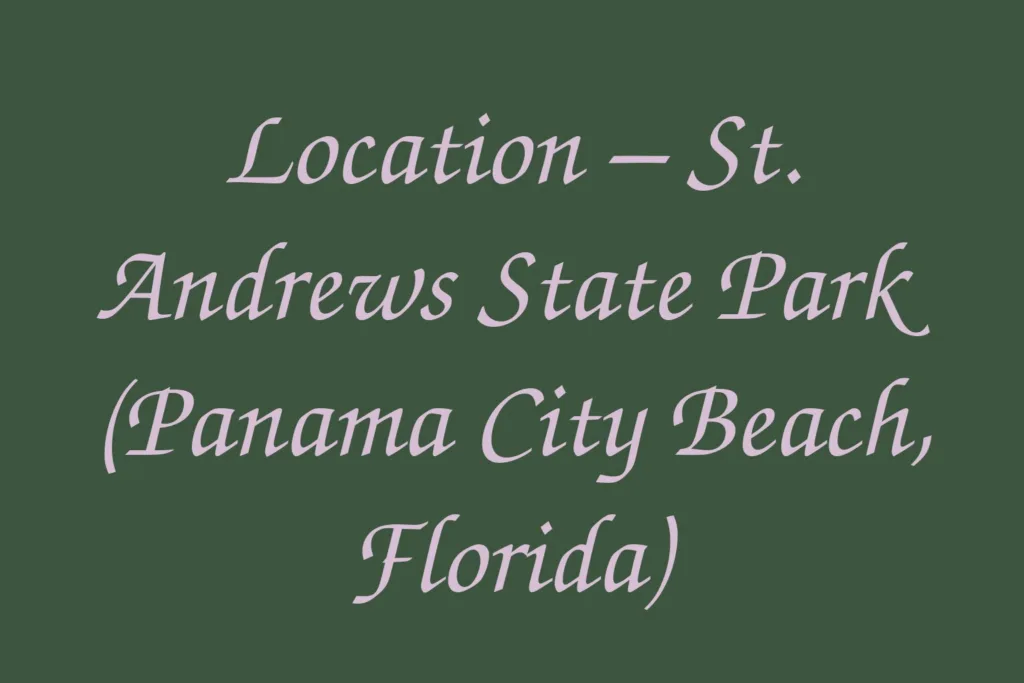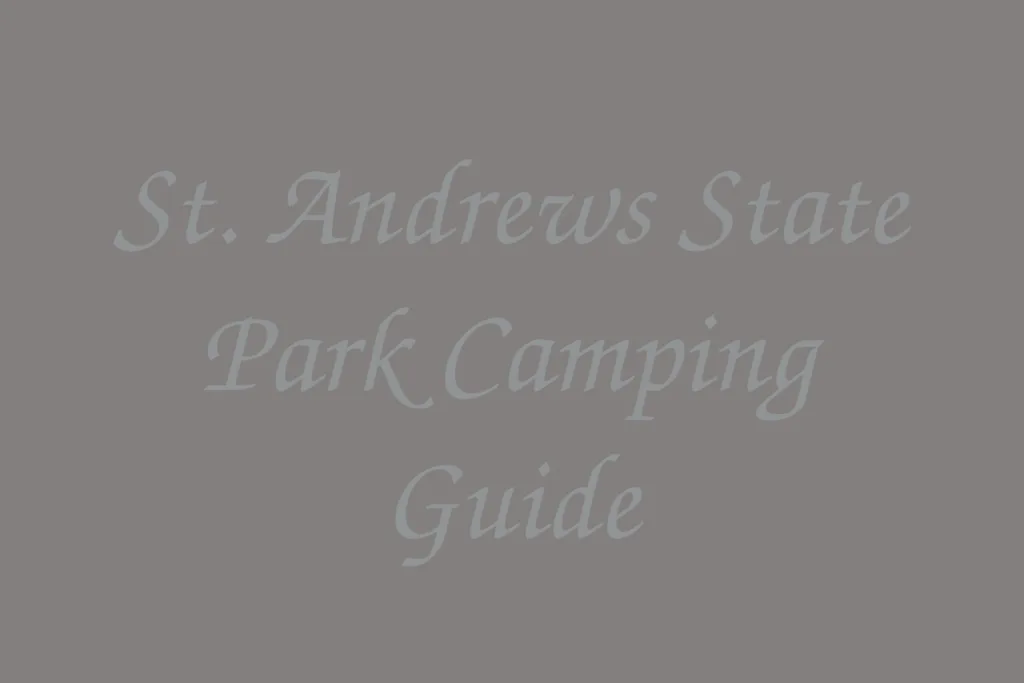Why the Flora Here Is Special
St. Andrews State Park sits at a meeting point of Gulf breezes, shifting sands, and fire-shaped pine ecosystems. That overlap creates a dense mosaic of native plants: dune grasses that anchor beaches, longleaf pines adapted to low-intensity burns, and marsh species that filter water and shelter wildlife. Learn the names and shapes below, then explore with care.
Coastal Dunes: Salt, Wind, and Sand
Dune plants are specialists. Their roots grip moving sand; their leaves tolerate salt spray and heat. Spot these along the beach access points and behind primary dunes.
Key Species to Recognize
- Sea Oats (Uniola paniculata) — Tall arching seed heads that sway above the dunes. Root systems knit sand together, forming natural storm buffers.
- Beach Morning Glory (Ipomoea pes-caprae) — A creeping vine with fleshy leaves and pink-to-lavender funnel flowers sprawling across foredunes.
- Seashore Elder (Iva imbricata) — Low, shrubby, and salt-hardy with overlapping leaves; often the first green you’ll see on the foredune ridge.
- Prickly Pear (Opuntia humifusa) — Prostrate cactus pads with yellow blooms; a classic sand specialist that supports pollinators and birds.
Where to look: Behind beach boardwalks and on secondary dunes. Stay off the vegetation; footprints can collapse root-held sand.
Pine Flatwoods & Maritime Hammocks: Fire-Shaped Forests
Past the dunes, the landscape opens to longleaf and slash pine with an understory of palmetto and wiregrass. Periodic, low fires keep these systems open and biodiverse.
Signature Trees & Understory
- Longleaf Pine (Pinus palustris) — Needles in large tufts and huge cones; seedlings look like grass for a year (“grass stage”) as they bank energy for a growth spurt.
- Slash Pine (Pinus elliottii) — Common companion to longleaf; look for glossy needles and slightly smaller cones.
- Saw Palmetto (Serenoa repens) — Fan-leafed, clonal palms forming low thickets; spring bloom spikes draw native bees.
- Live Oak (Quercus virginiana) — Broad, evergreen canopies often draped in Spanish moss; acorns fuel birds and small mammals.
- Southern Magnolia (Magnolia grandiflora) — Waxy, dark leaves and large, fragrant white blooms in warm months.
- Wiregrass (Aristida stricta) — Fine, tufted bunches that flower best after fire; crucial to the flatwoods’ ecology.
Where to look: Interior trails and picnic areas. After rains, listen for insects and watch for mushrooms emerging among pine needles.
Freshwater Edges & Marsh Margins: Life at the Waterline
Ponds, swales, and marsh fringes host plants that slow water, trap sediments, and provide nursery habitat for amphibians and fish.
Wetland Regulars
- Cattail (Typha latifolia) — Tall blades with cigar-shaped flower spikes; look for red-winged blackbirds nesting nearby.
- Pickerelweed (Pontederia cordata) — Heart-shaped leaves and purple flower spikes; a magnet for butterflies and native bees.
- Buttonbush (Cephalanthus occidentalis) — Spherical, pincushion-like flower heads used heavily by pollinators.
- Saltmeadow Cordgrass (Spartina patens) — On brackish edges; forms low, waving meadows that stabilize shorelines.
Where to look: Lagoon overlooks and pond margins. Bring binoculars—plants and birds share the same productive edges.
Bloom Windows & Seasonality
- Late Winter–Spring: Palmetto flowering begins; early wildflowers in open pine areas emerge after cool-season burns.
- Late Spring–Summer: Dune vines and beach blooms peak; magnolia flowers open; wetlands show maximum growth.
- Fall: Grasses seed heavily (watch sea oats and wiregrass); many shrubs fruit, feeding migratory birds.
- Winter: Evergreen structure stands out; best time to study bark, cones, and seed heads.
Field Ethics & Safety
Stick to signed paths, avoid trampling dune plants, and never collect seeds or cuttings. Pack out everything you bring in. Many species support nesting shorebirds, gopher tortoises, and pollinators—disturbance ripples through the food web.
Micro-Guides: Quick IDs in the Park
- Sea Oats vs. Other Tall Grasses
- Sea oats carry oat-like drooping seed panicles atop a single, tall culm; leaves feel slightly rough and blades are wider than most dune grasses.
- Longleaf vs. Slash Pine
- Longleaf needles: very long (often 10–18 inches) in bundles of three; cones are large and heavy. Slash pine needles are shorter and the bark plates are thinner.
- Pickerelweed vs. Arrowhead
- Pickerelweed leaves are heart-shaped with a distinct purple spike; arrowhead (Sagittaria) bears white three-petaled flowers and arrow-shaped leaves.
Rare & Notable Natives
Some plants in the region have limited ranges or sensitive populations. Keep a respectful distance and report unusual finds to park staff. Habitat health is often tied to regular, well-managed fire, intact dunes, and clean hydrology.
Trail Ideas for Plant Lovers
- Heron Pond Trail: A mix of pine flatwoods and wet edges—great for spotting palmetto, wiregrass, and wetland species in a single loop.
- Gator Lake Trail: Overlooks and pond margins with buttonbush and pickerelweed; bring a camera for dragonflies and wading birds.
- Boardwalks behind the beach: Safe vantage points to study sea oats and dune vines without damaging fragile sands.
Photo & Note-Taking Tips
- Shoot from knee height to capture leaf arrangement and growth habit.
- Include a finger or notebook edge near, not on, the plant for scale without touching it.
- Record microhabitat: foredune, secondary dune, flatwoods, pond edge, or marsh fringe.
FAQ
Can I collect seeds or cuttings?
No—collection harms fragile populations and is prohibited. Photograph and log observations instead.
What shoes are best?
Closed-toe hiking shoes for flatwoods and pond edges; sandals with heel straps for boardwalks and dry dunes.
How do I avoid harming dune plants?
Use designated boardwalks and stay off vegetated sand. Even a few steps can loosen roots and lead to erosion.


